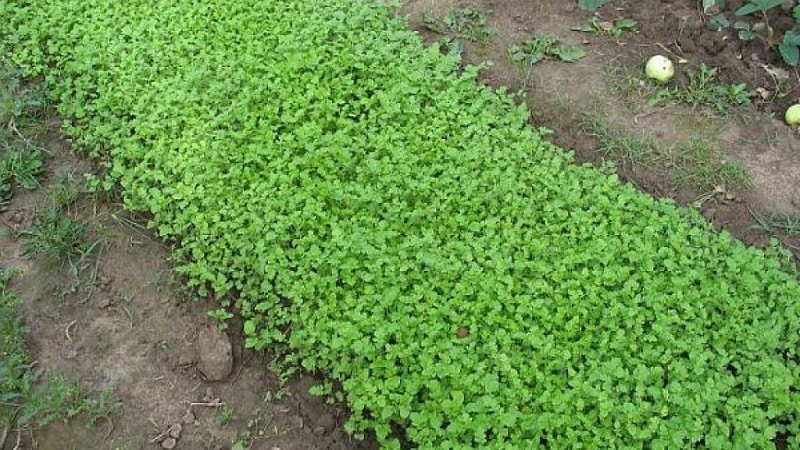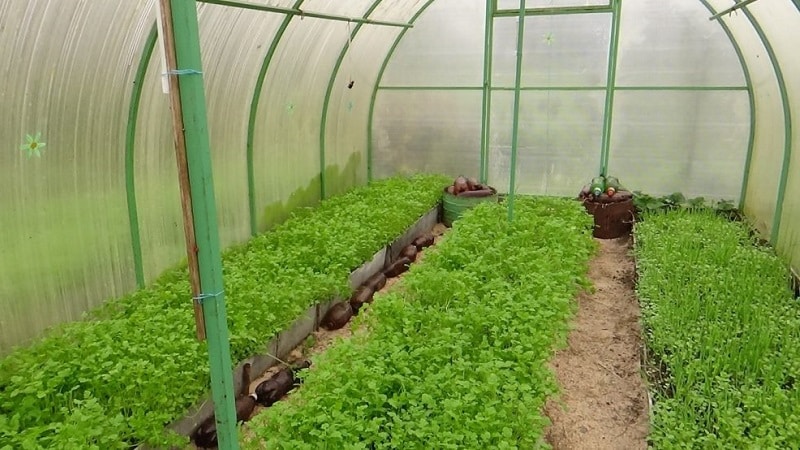Choosing the best green manure for cucumbers in the fall for greenhouses and open ground
Planting cucumbers in one place depletes the soil and contributes to the accumulation of infectious agents and pests. Crop rotation helps correct the situation. But what if the plot is small or the vegetable is grown in a greenhouse? Green manure will come to the rescue!
What is it, which ones to use for cucumbers and which ones to sow afterwards - read below.
What are green manures and why are they needed?
Technical crops grown to enrich the soil with nutrients and improving its structure are called green manures or “green fertilizers”.
Green manure plants are planted using one of the following methods::
- between rows between crops;
- as an early culture among later ones;
- at the end of summer or before winter;
- for the whole year while the soil is resting from intensive use.

Green manure is mowed before or shortly after flowering. and after rotting they are plowed into the ground.
Attention! Do not confuse green manure with weeds. Useful plants turn into weeds when the moment for mowing is missed and they have time to bloom and produce seeds.
The benefits of green manure for cucumbers
Sowing green manure plants before planting cucumbers restores soil fertility naturally and increases productivity. During the growth and subsequent decay of “green fertilizers”:
- the soil is enriched with nutrients: nitrogen, potassium, phosphorus and microelements;
- the soil is structured: the roots of green manure penetrate deep, loosen and improve aeration;
- soil microorganisms that fix nitrogen accumulate on dead roots;
- light sandy soils are bound and protected from erosion and weathering;
- the roots of beneficial plants deliver nutrients from the deep layers of the earth to the surface where the root system of cucumbers is located.
Planting green manure in between rows or around beds is useful.:
- their dense foliage, shading the soil, slows down the evaporation of moisture and inhibits the growth of weeds;
- companion plants repel or distract some of the cucumber pests;
- Most green manure plants are honey plants that attract bumblebees and bees, which also pollinate cucumbers.
It can be useful:
How to increase the yield of cucumbers in open ground
What green manure is best to plant before cucumbers in the fall?
It is recommended to sow plants that do not require heat., quickly (in 1–1.5 months) gaining green mass and easily rotting in winter. They have these qualities:
- White mustard. It quickly increases mass, heals the soil, prevents the appearance of cruciferous flea beetles and slugs, and cleanses the soil of spores of pathogenic fungi.
- Oilseed radish. Grows quickly, increases soil fertility, and prevents fungal and viral diseases.
- Cold-resistant phacelia. A universal green manure that rapidly accumulates biomass. Easily decomposes, makes the soil nutritious and loose.
- Oats. Enriches the soil with nutrients and minerals.
On a note. 10 acres of mown phacelia replace 300 kg of manure.
What crops are best not to plant under cucumbers?
In the open ground
It is better to plant more cold-resistant plants in open beds: winter rye, oilseed radish, phacelia.
When choosing green manure, it is worth considering the type of soil on the site:
- Phacelia and oilseed radish are ideal for depleted, sandy soils;
- Heavy clay soil is softened by legumes and grains.
On a note. Experienced vegetable growers sow beds with mixtures of green manure plants. Plants complement each other, the fertilizer is more balanced.
In the greenhouse
When growing cucumbers in a greenhouse or greenhouse, observing crop rotation is problematic.. If you can enrich the soil with nutrients using organic and mineral fertilizers, it is difficult to cope with the accumulation of pests and pathogens.
In this case, mustard is indispensable. The green mass of the plant disinfects and saturates the soil with nutrients. When greening in greenhouses, good results are shown by watercress and oats, which are characterized by high growth rates.
Attention! When using the same “green fertilizer” from year to year, the soil is oversaturated with some substances and lacks others. Green manure must be alternated.

How to properly plant green manure for cucumbers in the fall
Autumn green manures are planted after the harvest is complete., usually from mid-August to mid-September. There are several reasons to sow them in the fall:
- Saving time in spring. There is no need to plant and wait for them to germinate to prepare your beds.
- Green manure plants stay on the site longer, their root system better loosens the soil and additionally saturates it with oxygen.
- Protecting the soil from drying out and frost. Green manure remaining on the surface retains snow and moisture longer.
Read also:
How to pinch cucumbers correctly - when and why you need it
Why are cucumbers bitter, how to prevent it and what to do with the harvest
In the open ground
Having decided on the choice of green manure plant, we begin work.:
- The designated area is cleared of tops and weeds.
- If the soil is severely depleted, potassium-phosphorus fertilizers are applied.
- Dry soil is spilled with water, dug up to a depth of 5–10 cm and loosened.
- The seeds are distributed over the bed, covered with a rake and sprinkled with compost. The crops must be very dense.
On a note. Birds are not averse to eating green manure seeds. To secure your plantings, install a scarecrow.
In the greenhouse
The stages of sowing work in a greenhouse are the same as in open beds. But the seedlings will appear earlier - already on days 5–7.
Treatment of beds with green manure
Plants that sprouted in autumn are not touched.. A dense layer of greenery will create a kind of mulch, and with the onset of cold weather and shortening of daylight hours, green manure will stop growing.
With the onset of spring, “green manure” begins to grow again. When they reach a height of 20–25 cm, they are mowed and left in the garden bed.. Plant residues quickly rot. The beds with green manure humus are dug up and cucumbers are planted after 2–3 weeks.
Cucumbers have no special requirements for green manure plants. However, it is not recommended to plant them after zucchini, pumpkins, watermelons and melons. After these plants, the cucumber yield will be lower.
There is no need to place cucumbers and beds next to each other. celery, parsley, sweet pepper, onions.

What green manure to sow after cucumbers
Cucumbers extract many nutrients from the soil. There is an accumulation of pathogens. The roots of the vegetable release colins into the soil - substances of various structures that suppress the vital activity of other plants.
Will help prepare the soil for subsequent plantings:
- mustard - heals the soil;
- vetch-oat mixture - restores fertility, enriches the soil with nitrogen, slows down the growth of weeds.
Let's sum it up
Green manure is grown to restore and increase soil fertility, improve its structure, and increase the number of beneficial soil microorganisms. Green manure plants are unpretentious, quickly grow green mass, and rot easily.
Autumn green manure is usually carried out on cucumber beds. Useful plants are sown densely throughout the area after harvesting, allowed to grow and left until spring. In the spring, after regrowth, they are mowed down and left to decompose. Then the beds are dug up and cucumbers are planted after 2-3 weeks.
Most often, white mustard, legumes, cereals, and mixtures of these plants are used for cucumbers. Cucumbers have no special requirements for green manure, but after them it is better to prepare the soil for other crops using mustard or vetch-oat mixture.